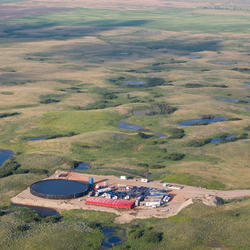Energy Integrated Science Team
The Energy Integrated Science Team focuses on the potential for contaminant exposures in the environment that might originate from energy resource activities including, transportation, storage, extraction, waste management and restoration. Perceived health risks to humans and other organisms will be distinguished from actual risks, if any.
If actual risks are identified this project will inform how to economically and effectively minimize risk by providing scientific data and understandings about the environmental transport, fate, and exposure pathways of contaminants. Emphasis will be placed on addressing these issues on public and Department of Interior manageed lands.
The United States is one of the largest users of energy, consuming annually about one-quarter of the energy resources produced in the world. The energy industry and government regulators work to provide energy resources to the public safely and effectively. Management of energy byproducts such as waste materials (including both solid and liquid wastes) from oil and gas development are a critical part of that work. However, spills, leaks, and other factors can create pathways for contaminants to enter the environment and result in exposures to humans and biota.
The associated health effects of specific spills have not been demonstrated in many cases, yet the perception of risk can drive action by industry and regulators. Hydrologists, chemists, biologists, and geologists on the Team conduct studies outside the mission of other federal agencies, by assessing actual versus perceived health effects to humans and biota due to exposures to energy production materials in the environment. This effort utilizes a watershed-and aquifer-based interdisciplinary science approach, providing a "big picture" that helps show where energy development activities are causing adverse health impacts on biota due to environmental contaminant exposures, as well as where they are not causing impacts. With this information in hand industry, land managers and other decision makers are able to balance the critical need for energy with further action, if any, to minimize health risks associated with energy production materials in the environment.
Current Science Questions and Activities
- Materials from oil and gas (OG) extraction may contain toxic or radioactive elements from the geologic formation, additives such as biocides used during OG development, and products of natural degradation. What is the composition of the materials generated, the potential pathways to the environment, the mode-of-action and the effects, if any, on receptor organisms from exposure to these constituents?
- Energy development occurs nationwide on public and private lands at scales ranging from town to regional to state-level development. This work is focused on the regional, and especially watershed or aquifer scale, energy-resource associated releases (for example spills, pipeline breaks) to the environment. Are there contaminant exposures and actual, not perceived, public health concerns throughout the watershed or underlying aquifers downstream or downgradient of the release?
- Releases of energy-associated materials to the environment can occur at various time scales thereby altering biogeochemistry and potential health effects on fish and wildlife as well as contaminant exposures to humans. Is persistence related to actual health effects?
- Assess the literature and compile stakeholder input to inform future science priorities. What are the science gaps in understanding the potential contaminant-related health risks to humans and other organisms from coal and non-fossil fuel energy sources such as hydroelectric power, wind, solar, and batteries?


